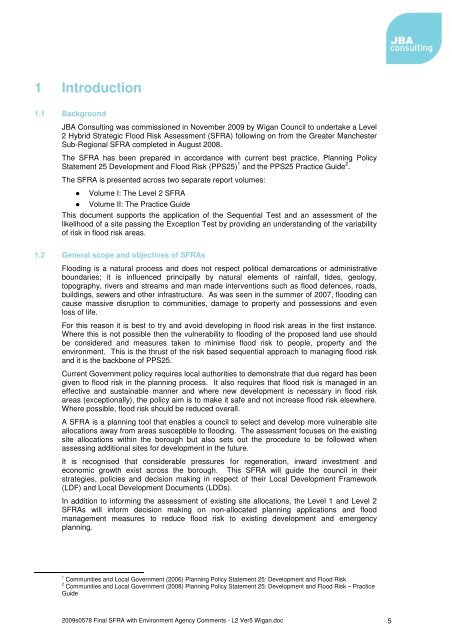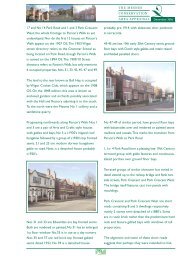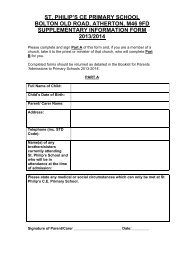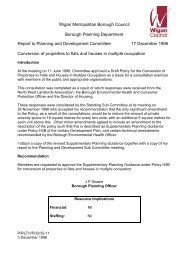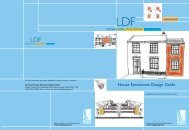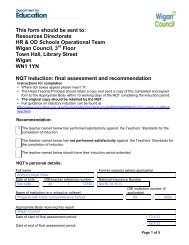Level 2 Strategic Flood Risk Assessment (.pdf ... - Wigan Council
Level 2 Strategic Flood Risk Assessment (.pdf ... - Wigan Council
Level 2 Strategic Flood Risk Assessment (.pdf ... - Wigan Council
You also want an ePaper? Increase the reach of your titles
YUMPU automatically turns print PDFs into web optimized ePapers that Google loves.
1 Introduction1.1 BackgroundJBA Consulting was commissioned in November 2009 by <strong>Wigan</strong> <strong>Council</strong> to undertake a <strong>Level</strong>2 Hybrid <strong>Strategic</strong> <strong>Flood</strong> <strong>Risk</strong> <strong>Assessment</strong> (SFRA) following on from the Greater ManchesterSub-Regional SFRA completed in August 2008.The SFRA has been prepared in accordance with current best practice, Planning PolicyStatement 25 Development and <strong>Flood</strong> <strong>Risk</strong> (PPS25) 1 and the PPS25 Practice Guide 2 .The SFRA is presented across two separate report volumes:Volume I: The <strong>Level</strong> 2 SFRA Volume II: The Practice GuideThis document supports the application of the Sequential Test and an assessment of thelikelihood of a site passing the Exception Test by providing an understanding of the variabilityof risk in flood risk areas.1.2 General scope and objectives of SFRAs<strong>Flood</strong>ing is a natural process and does not respect political demarcations or administrativeboundaries; it is influenced principally by natural elements of rainfall, tides, geology,topography, rivers and streams and man made interventions such as flood defences, roads,buildings, sewers and other infrastructure. As was seen in the summer of 2007, flooding cancause massive disruption to communities, damage to property and possessions and evenloss of life.For this reason it is best to try and avoid developing in flood risk areas in the first instance.Where this is not possible then the vulnerability to flooding of the proposed land use shouldbe considered and measures taken to minimise flood risk to people, property and theenvironment. This is the thrust of the risk based sequential approach to managing flood riskand it is the backbone of PPS25.Current Government policy requires local authorities to demonstrate that due regard has beengiven to flood risk in the planning process. It also requires that flood risk is managed in aneffective and sustainable manner and where new development is necessary in flood riskareas (exceptionally), the policy aim is to make it safe and not increase flood risk elsewhere.Where possible, flood risk should be reduced overall.A SFRA is a planning tool that enables a council to select and develop more vulnerable siteallocations away from areas susceptible to flooding. The assessment focuses on the existingsite allocations within the borough but also sets out the procedure to be followed whenassessing additional sites for development in the future.It is recognised that considerable pressures for regeneration, inward investment andeconomic growth exist across the borough. This SFRA will guide the council in theirstrategies, policies and decision making in respect of their Local Development Framework(LDF) and Local Development Documents (LDDs).In addition to informing the assessment of existing site allocations, the <strong>Level</strong> 1 and <strong>Level</strong> 2SFRAs will inform decision making on non-allocated planning applications and floodmanagement measures to reduce flood risk to existing development and emergencyplanning.1 Communities and Local Government (2006) Planning Policy Statement 25: Development and <strong>Flood</strong> <strong>Risk</strong>2 Communities and Local Government (2008) Planning Policy Statement 25: Development and <strong>Flood</strong> <strong>Risk</strong> – PracticeGuide2009s0578 Final SFRA with Environment Agency Comments - L2 Ver5 <strong>Wigan</strong>.doc 5


